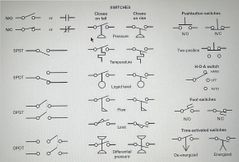![]()
![]()
![]()
Use LEFT and RIGHT arrow keys to navigate between flashcards;
Use UP and DOWN arrow keys to flip the card;
H to show hint;
A reads text to speech;
10 Cards in this Set
- Front
- Back
|
What are the 5 basic parts of a schematic diagram? |
(1)A power supply (2)A path for the power (3)A load component (4)A switch that interrupts power (5)A legend or key explaining the symbols. |
|
|
What are the 3 different types of wiring diagrams? |
(1) Ladder (shows the logic and helps with diagnosis)
(from this point forward the paper refers to schematic diagrams as ladder however all three types are schematic diagrams) (2) line diagram (drawings that closely resemble the components and show their layout) (3)installation diagram (shows the field wiring only. Very rarely, shows the internal wiring of the unit.) |
|
|
Two wires that cross paths with no connection on a schematic diagram will indicate that there is no connect by having no dot or a loop. T of F? |
True. |
|
|
Is a transformer a load or a power source? |
For a step down control circuit transformer. On the high voltage ladder diagram it is a load. On the low voltage ladder diagram it is a power source. |
|
|
Are loads on the left or right side of a ladder diagram? |
Loads are on the right. Load side. Switches are on the left. Line side. |
|
|
What do the numbers on the right side of the ladder mean? |
They are telling you where those components have contacts located on other parts of the ladder diagram. The left hand side will have numbers indicating all of the rungs locations. |
|
|
What is a legend? |
Legends will tell you what all of the abbreviation mean. |
|
|
A wiring diagram will show the switches when they are powered or unpowered? |
Unpowered.
If there is a device that deviates from this practice you can read this in the notes. |
|
|
What do all the switches look like on a ladder diagram? Flow, liquid level? Limit? Differential pressure? Temperature? Note: if the bar is above the switch is an energize on drop of “x”. If bar is above the switch is an energize on rise of “x” |

Back (Definition) |
|
|
What do all the relays look like in the ladder diagram? |

Back (Definition) |

